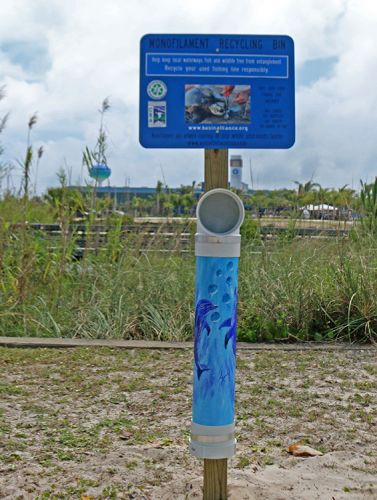
 Local artist Annette Taunton (left) and CBA Director Alison McDowell (right)
Local artist Annette Taunton (left) and CBA Director Alison McDowell (right)
For a few months this winter, my office in Okaloosa County became storage space for ten monofilament recyclers. Wide PVC pipes had been painted with beautiful marine designs — from herons to crabs to mermaids — by local wildlife artist Annette Taunton, and were ready for installation near piers and marinas across Okaloosa County.
Along the coast of Florida, fishing is an immensely popular activity. According to a 2011 survey, 2.4 million saltwater anglers try their luck in Florida every year, making this southern state the first in the nation. In fiscal year 2013–2014, Florida sold more than 1.6 million recreational saltwater licenses, raking in over $35 million in revenue. Because of the high number of anglers, this industry generates over 100,000 jobs.
Unfortunately, there are environmental tolls that go hand-in-hand with this economic impact. When anglers get line tangled or caught on a fish or subsurface snag, fishing line (also known as monofilament) gets discarded right into the water. Designed to be nearly invisible, the monofilament entangles every kind of marine life, from dolphins and sea turtles to pelicans and more, resulting in serious injury and death.
Scenes of entangled animals can be terrible, but thankfully there is now something coastal inhabitants can do about it. That’s where the monofilament recyclers come in.

Alison McDowell, Director of the CBA, explains, “CBA is excited to extend the reach of our fishing line recycling program through this partnership with Okaloosa County. The ten new recycling sites will help prevent wildlife entanglement and plastic pollution, and have a positive impact on our local environment.”
Despite the important recycler installation CBA had already accomplished, many more bins were needed along the Okaloosa Island fishing pier and in county parks near the water. The bins were painted with both whimsical and stunning images — guaranteed to stop the average visitor or local exploring the pier. With educational signs set up over every monofilament bin, they hope to educate everyone about the importance of keeping monofilament line out of the Gulf of Mexico.
We along the Emerald Coast are not alone in our monofilament recycling movement. The Florida Fish and Wildlife Conservation Commission started the Monofilament Recovery & Recycling Program, “a statewide effort to educate the public on the problems caused by monofilament line left in the environment, to encourage recycling through a network of line recycling bins and drop-off locations, and to conduct monofilament line cleanup events.” Today, over 40 counties have recycling bins within their borders, and more are being added all the time.
Okaloosa County Board of County Commissioners’ Chairman Carolyn Ketchel adds, “This is an excellent example of Okaloosa County’s commitment to recycling. Not only have we just expanded to larger recycling trash cans, but the carpet that will be installed at the airport is made from recycled fishing line. I applaud this partnership between the Okaloosa County Tourist Development Group and the Choctawhatchee Basin Alliance.”
We cannot prevent all fishing line from entering the water. However, given how much the marine world gives us, it remains our responsibility to do the best we can to protect our natural resources. We are fortunate to be able to do our part along the Emerald Coast in such a colorful and creative way.